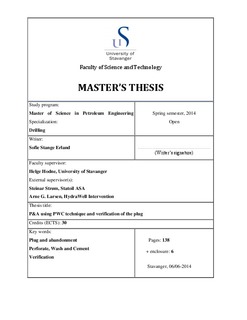| dc.contributor.author | Erland, Sofie Stange | |
| dc.date.accessioned | 2014-09-22T07:11:30Z | |
| dc.date.available | 2014-09-22T07:11:30Z | |
| dc.date.issued | 2014-06-16 | |
| dc.identifier.uri | http://hdl.handle.net/11250/220739 | |
| dc.description | Master's thesis in Petroleum engineering | nb_NO |
| dc.description.abstract | When a well is permanently plugged and abandoned (P&A), a plug has to be set over the entire cross section of the well. The conventional method to perform a P&A operation is to mill the casing and pull it to surface before plugging the well, which is a time consuming and expensive method. The perforate, wash and cement (PWC) method is a very interesting technology. It has the possibility to be both faster and more cost effective than a milling operation.
Today the main challenge for the PWC technology is the time consumption on the verification of the plug. For a milling operation the cement will always cover the entire plugging area, as this is an open hole. When plugging a well with the PWC technology the cement is forced through small perforations into the annulus or both annuli. Continuous cement in the annulus has to be verified to approve the plug. For a single casing, this can easily be performed by drilling the plug and logging the annulus. The challenge arises when two casings are cemented, because currently there are no technologies available to log through two casings. Reducing the time used on drilling the plug and logging the cement is the key for the PWC technology to become a cost effective P&A method. When operators have set enough successful plugs to rely on the PWC technology, there will be no need to drill out the plug and log the annulus anymore. The verification of the plug can then be performed according to NORSOK D-010 requirements, which is pressure testing and tagging of the plug. So for now the largest challenge is to verify continuous cement in two annuli, and finding a technology to get a faster and more accurate result when pressure testing the plug.
The main scope with this thesis is to give an insight into the PWC technology, discuss the verification challenges, and suggest solutions for future verification methods. It also gives an insight into the regulations and requirements that a P&A operation needs to fulfill. The thesis is divided into four parts; description of NORSOK D-010 regulations and requirements for a P&A operation, general theory for cementing and verification, the PWC technology, and finally a verification, discussion and conclusion part. | nb_NO |
| dc.language.iso | eng | nb_NO |
| dc.publisher | University of Stavanger, Norway | nb_NO |
| dc.rights | Attribution-NoDerivs 3.0 Norway | * |
| dc.rights.uri | http://creativecommons.org/licenses/by-nd/3.0/no/ | * |
| dc.subject | petroleumsteknologi | nb_NO |
| dc.subject | plug and abandonment | nb_NO |
| dc.subject | verification | nb_NO |
| dc.subject | brønnteknologi | nb_NO |
| dc.subject | perforate, wash and cement | nb_NO |
| dc.subject | p&a | nb_NO |
| dc.title | P&A using PWC technique and verification of the plug | nb_NO |
| dc.type | Master thesis | nb_NO |
| dc.subject.nsi | VDP::Technology: 500::Rock and petroleum disciplines: 510::Petroleum engineering: 512 | nb_NO |
| dc.source.pagenumber | 144 | nb_NO |

